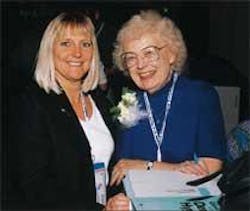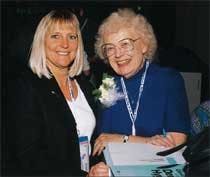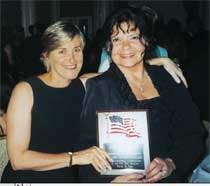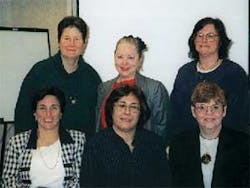The Academy
by Joyce Ann Turcotte, RDH, MEd
We are all members of groups. When asked to describe who we are, most of us include information about these groups. Membership is defined as the relationship between a person and a group. In fact, concepts of membership and groups are so closely related that groups are often defined in terms of members, according to Napier and Gershenfeld, authors of Groups: Theory and Experience.
If you are an active person, you're most likely associated with several groups. Religious, educational, political, professional, gender, activity, and age-related organizations are just a few examples how people connect with others with similar interests. Levels of involvement may vary from limited "dues-paying, card-carrying" role to chairing a council or being an officer.
However, joining a group doesn't always connect you to the people within that group. Have you ever experienced that first time at a meeting where no one approaches you? How about the other end of the spectrum — attending a meeting for the first time and being nominated for a committee!
Finding a group that reflects your values, attitudes, and beliefs takes some time. As busy as we are in today's society, connecting with the right group is important. According to Napier and Gershenfeld, a person may join a group for one or more of the following reasons:
• They like the task or activity
• They like the people
• The group serves a networking or status position
When you find a group that aspires to higher standards and propels the goals of the organization through effective leadership and active membership, you are drawn to become part of it. That is why I joined the American Academy of Dental Hygiene (AADH) in 1989. This Association is rich in ideas, vision, and leadership — an excellent combination for advancing the profession of dental hygiene.
When members were asked what the Academy means to them, president Linda Bohacek, RDH, MS, of Eau Claire, Wis., said, "I saw the Academy as an opportunity to support high quality continuing education courses. Also, the opportunity to network with dental hygienists who believe in establishing an approval process for continuing education courses that would ensure quality CE was important to me. Finally, I have always been a strong supporter of opportunities to recognize dental hygienists who go the extra mile to serve their community, patients/clients, and profession."
Esther Wilkins, RDH, DMD of Boston, was made an honorary member in 2001. She was recognized by the Academy for excellence in the practice of dental hygiene.
Dr. Wilkins said, "Being a part of the AADH gives me a great deal of pride. The Academy represents the highest in dental hygiene ethics and learning. After meeting rigid admission requirements, each member is required to meet a standard of continuing education to maintain membership. The dental hygiene profession is a dynamic, growing health-care group, and high standards of self-motivation are needed to keep up with the new research, new inventions, and new methods. The members of the AADH are dedicated to this standard of learning and study. I admire, appreciate, and promote that in our profession."
Ann-Marie DePalma, RDH, BS, a new member from Stoneham, Mass., said, "I wanted to become an Academy member because as a continuing-education presenter and clinical hygienist, I feel it is important to remain on the cutting edge of the profession of dental hygiene. We need to constantly educate and challenge ourselves so that we can better educate our patients/clients regarding all available treatment modalities and commercial products available. I'm looking forward to attending the CE programs, networking with hygienists of similar thinking, and becoming a part of the organization.
Another new member, Leslie Andrews, RDH, MBA, of Norwalk, Conn., added, "As a dental hygienist, I have always tried to practice at the highest standard of care. As a professional educator, it becomes a responsibility to support that high standard. After we have graduated from dental hygiene school, other than further degree completion, our best resources to learn and grow are our journals and attending continuing education courses. The American Academy of Dental Hygiene was founded as a national CE accreditation service by dental hygienists practicing to that high standard. I am proud to be a member and to support that effort."
The history
In the 1980s, the American Dental Hygienists' Association (ADHA) investigated numerous issues regarding self-regulation and autonomy. The direction of the House of Delegates to the Board of Trustees and the Council on Education was to form a "College of Dental Hygiene." This was to be an entity under the auspices of ADHA that would be responsible for the recognition of excellence in dental hygiene and be a resource for the communities of interest. Since the continuing education registry of ADHA disbanded, the visible presence of the organization did not exist in continuing education.
There did exist a number of organizations that had a title of Academy in various states. A number of dental hygienists from the northeast joined together to frame out a unique organization focusing on excellence in education. Original founders of the American Academy of Dental Hygiene included Olga Ibsen, Konetta Putman-Sparks, Linda Bohacek, Judith Friedman, Susan Rod Graham, and Elizabeth Pitz. In 1987, AADH was granted federal incorporation status.
The Academy is an association with chapters in 12 states. Other states can apply for a charter to develop local chapters.
AADH's goals
The academy's goals are:
• Foster the continuing pursuit of education and research in the art and science of dental hygiene
• Provide formal recognition of excellence in the practice of dental hygiene
• Recognize distinguished community service in the effort to foster improved oral health
In order to attain these goals it was necessary to address the continued education of the practicing dental hygienist. Formalized education was already accredited, yet there was no standard for informal professional continuing education. The AADH developed standards for this non-accredited education so that courses could be evaluated relative to content, depth, accuracy, and outcome. AADH incorporated its structure and direction features from the American Academy of Periodontology.
Former President Olga Ibsen, RDH, MS, states, "Thanks to Nancy Barnes, AADH has become a well respected organization responsible for accrediting continuing education courses for dental hygienists. These standards have been accepted by various state licensing agencies for satisfying continuing education requirements. Continuing education has been and will continue to be a mission of AADH."
Barnes is the AADH's executive director, as well as a past president and editor. A practicing hygienist, she is also a member of the New York State Board of Dentistry and an examiner for the Northeast Regional Board.
The process for evaluating courses was developed and refined during the past 12 years. The Course Approval Committee of AADH conducts the review process. The committee consists of dental hygiene professionals who volunteer their time and expertise. There are 47 states and the District of Columbia that require continuing education for re-registration, 28 states require advanced sponsor approval, and 14 require course approval, according to the ADHA. Each state has different mechanisms for how credit is monitored and how the individual is validated. Since there was no established national dental hygiene standard, AADH has filled this void since 1985. Many states, corporations, colleges, and the International Dental Hygiene Federation have recognized the importance of a single standard and process for approval of continuing education.
In 1997, the state of New York put forth regulations indicating which agencies would be approved providers of CE. The AADH presented to the New York State Education Department the criteria, standards, and necessary paperwork for consideration, and the AADH was subsequently granted approval status.
Besides being involved in developing standards for continuing education courses, AADH also reviews entities for approval as providers/sponsors, provides state agencies with a recognized organization that oversees the formal continuing education of dental hygienists, and administrates over the membership of the AADH.
In order to join this association, application for provisional status initiates the process towards full membership. There is a nominal application fee and annual dues. The membership committee reviews the application and makes recommendations to the Governing Council (GC).
Criteria for full membership are:
• Current licensure or current state dental hygiene registration
• 75 hours of continuing education
• 750 hours of clinical practice/alternative practice settings
• Completed application submitted with fee and final GC approval.
After three years of full membership, application must meet strict guidelines below for fellowship:
• Provide documentation of achievement of a Baccalaureate degree or higher
• Fulfill three of the following four additional criteria:
• leadership through holding office
• community service
• published research paper
• continuing education presenter
• Provide a case presentation documenting clinical skills at an AADH Annual Meeting
Where: Courtyard Marriott — Tarrytown, N.Y.
When: October 24
Agenda: Continuing education, a business and networking session, breakfast and lunch.
Who: General attendance is welcome and application for membership will be available.
Contact: To request information about the meeting or a membership application, contact Nancy Barnes, RDH, Executive Director, [email protected] or POB 328, Farmingdale, NY 11735, or Joyce Turcotte at [email protected] or (203) 261-2857.
Joyce Ann Turcotte, RDH, MEd, is president and owner of Professional Learning Services, a continuing education business since 1987. She is an educator, continuing education lecturer, and consultant for organizations and businesses.



